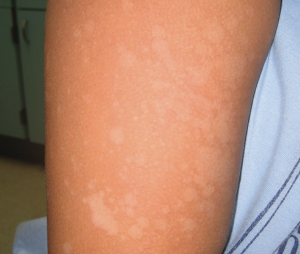Chapter 13: Disorders of Pigmentation
Hyper- or Hypo-pigmented Lesions
Post-inflammatory pigment changes
Post-inflammatory pigment changes are commonly seen after resolution of a rash or skin injury. This is very common with atopic dermatitis, psoriasis or acne vulgaris. Resolution of inflammation can leave either hyper-pigmentation, from deposition of pigment in the dermis, or hypo-pigmentation, from a temporary halt in production of pigment. These pigment changes can occur in any patient but are especially common in darker skin of colour. These pigment changes usually last for months after the skin eruption has resolved and do not need to be treated. Sun protection is helpful as tanning of normal skin makes hypopigmented areas more prominent, and hyperpigmented areas will become even darker.

Pityriasis Versicolor
Pityriasis versicolor, as its name suggests, can present as a variety of colour changes on the skin, including areas that are hyper- or hypo-pigmented. For a full description of Pityriasis versicolor see the Infection and Infestations section.

Pigmentary Mosaicism
Pigmentary mosaicism occurs when patients have two different skin tones in a pattern that corresponds to migration pattern of skin cells during embyogenesis (Lines of Blaschko). These pigment changes arise from genetic mosaicism in the skin cells. Most patients do not have any associated symptoms or syndromic features associated with the pigmentary mosaicism, and no further evaluation or treatment is necessary. Occasionally, widespread pigmentary mosaicism can be seen in conjunction with neurologic changes, such as has been reported in hypomelanosis of Ito, linear and whorled nevoid hypomelanosis, and Blaschkoid dyspigmentation.

